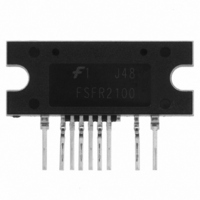FSFR2100 Fairchild Semiconductor, FSFR2100 Datasheet - Page 12

FSFR2100
Manufacturer Part Number
FSFR2100
Description
IC SWIT PROG OVP OCP 9SIP
Manufacturer
Fairchild Semiconductor
Series
FPS™r
Datasheet
1.FSFR2100.pdf
(16 pages)
Specifications of FSFR2100
Output Isolation
Isolated
Frequency Range
94kHz ~ 106kHz
Voltage - Input
9.6 V ~ 25 V
Voltage - Output
500V
Power (watts)
400W
Operating Temperature
-40°C ~ 130°C
Package / Case
9-SIP
Output Voltage
24 V
Output Current
8.3 A
Output Power
450 W
Switching Frequency
300 KHz
Operating Temperature Range
- 40 C to + 130 C
Mounting Style
Through Hole
Duty Cycle (max)
52 %
Isolated/non-isolated
Isolated
For Use With
FEB212 - BOARD EVAL FOR FSFR2100
Lead Free Status / RoHS Status
Lead free / RoHS Compliant
Available stocks
Company
Part Number
Manufacturer
Quantity
Price
Part Number:
FSFR2100
Manufacturer:
FAIRCHILD/仙童
Quantity:
20 000
Company:
Part Number:
FSFR2100U
Manufacturer:
Fairchild Semiconductor
Quantity:
1 885
Part Number:
FSFR2100U
Manufacturer:
CN/如韵
Quantity:
20 000
Company:
Part Number:
FSFR2100XS
Manufacturer:
RENESAS
Quantity:
2 500
Part Number:
FSFR2100XS
Manufacturer:
FCS
Quantity:
20 000
© 2007 Fairchild Semiconductor Corporation
FSFR2100 • Rev.1.0.8
6.2
triggered, switching is terminated and the MOSFETs
remain off. The latch is reset only when LV
discharged below 5V.
6.3
sensing pin voltage drops below -0.58V, OCP is triggered
and the MOSFETs remain off. This protection has a
shutdown time delay of 1.5µs to prevent premature
shutdown during startup.
6.4
the secondary rectifier diodes are shorted, large current
with extremely high di/dt can flow through the MOSFET
before OCP or OLP is triggered. AOCP is triggered
without shutdown delay when the sensing pin voltage
drops below -0.9V. This protection is latch mode and
reset when LV
6.5
defined as the load current exceeding its normal level
due to an unexpected abnormal event. In this situation,
the protection circuit should trigger to protect the power
supply. However, even when the power supply is in the
normal condition, the overload situation can occur during
the load transition. To avoid premature triggering of
protection, the overload protection circuit should be
designed to trigger only after a specified time to
determine whether it is a transient situation or a true
overload situation. Figure 26 shows a typical overload
protection circuit. By sensing the resonant capacitor
voltage on the control pin, the overload protection can be
implemented. Using RC time constant, shutdown delay
can be also introduced. The voltage obtained on the
control pin is given as:
where V
voltage.
V
CON
=
2(
Cr
Latch-Mode Protection: Once this protection is
Over-Current Protection (OCP): When the
Abnormal Over-Current Protection (AOCP): If
Overload
C
p-p
B
C
+
Figure 27. Protection Blocks
is the amplitude of the resonant capacitor
B
C
CC
sense
is pulled down below 5V.
)
V
Cr
Protection
p p
−
(OLP):
Overload
CC
(7)
is
is
12
6.6
LV
used when auxiliary winding of the transformer to supply
V
6.7
the control IC in one package makes it easy for the
control IC to detect the abnormal over-temperature of the
MOSFETs. If the temperature exceeds approximately
130°C, the thermal shutdown triggers.
7.
Duty unbalance problems may occur due to the radiated
noise from main transformer, the inequality of the
secondary side leakage inductances of main transformer,
and so on. Among them, it is one of the dominant
reasons that the control components in the vicinity of R
pin are enclosed by the primary current flow pattern on
PCB layout. The direction of the magnetic field on the
components caused by the primary current flow is
changed when the high and low side MOSFET turns on
by turns. The magnetic fields with opposite direction from
each other induce a current through, into, or out of the R
pin, which makes the turn-on duration of each MOSFET
different. It is highly recommended to separate the
control components in the vicinity of R
primary current flow pattern on PCB layout. Figure 28
shows an example for the duty balanced case.
CC
CC
to FPS™ is utilized.
reaches 23V, OVP is triggered. This protection is
Figure 28. Example for Duty Balancing
Over-Voltage Protection (OVP): When the
Thermal Shutdown (TSD): The MOSFETs and
PCB Layout Guidelines
T
www.fairchildsemi.com
pin from the
T
T








